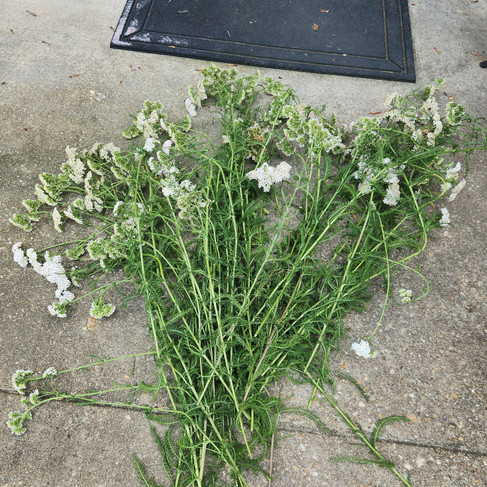Yarrow!!
- Yvonne Muse
- Aug 4
- 2 min read

This is Yarrow, Achillea millefolium. Yarrow is known for her healing and protective properties. Anti-inflammatory, anti-microbial, diaphoretic, sedative, and styptic, Yarrow is also known as the warrior's herb. Yarrow gets its name Achillea from its use by Achilles in the Battle of Troy. He used it to staunch his warriors bleeding and heal their wounds. Yarrow has been used extensively throughout history in this way, including during the Civil War. The millefolium part of her name comes from her fern like leaves, it means thousands of leaves in Latin.
(Hover over any of the images for descriptions!)
Yarrow typically has many longer leaves at the bottom with them spiraling up the 1-3' stalk, getting more sparse as they go. Her flower does not form a true umbel (many flower stalks originating from one single point) but it does look kind of like an umbrella with a few flower heads covered in tiny flowers coming from one or more central stalks. Her flowers are usually off white but can be pink or other colors in various cultivars.
Correct ID is, as always, vital. Once you know her you'll see her everywhere but she has dangerous lookalikes. Wild carrot (also known as Queen Anne's lace) is mostly harmless but poison hemlock or giant hogweed are toxic to humans and could be mistaken by someone unfamiliar with the plant.
The 5 pictures below show L to R, top to bottom -
water hemlock (x2), wild carrot (x2), and boneset (x2).
The leaves and flowers are used primarily, although the stalk could be used in oil or tincture also. Leaves and flowers are removed pretty easily for dehydrating for later use or can be used fresh as a poultice. Yarrow has a bitter taste and a unique, kinda medicinal (possibly unpleasant) scent to her flowers or her leaves when crushed. Her bitter taste helps stimulate digestive juices for those with slow digestion and was used to make gruit to brew beer before hops!
I recently harvested and dehydrated yarrow from my garden. It's recommended that you harvest when the blooms are fully open and when you can smell it and in the afternoon once the dew has evaporated. Typically when I'm processing herbs I'll leave them on the step for a bit to wilt and to let the bugs wander off. I then separated the blooms from the leaves and dehydrated fully! Ready to be made in to tincture and powdered.
Yarrow is a super beneficial, incredibly common friend to have when you're traipsing about and get a boo boo. Hope this helps!!





























Comments